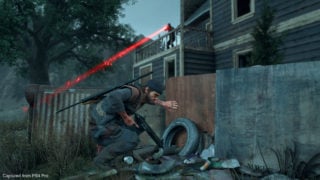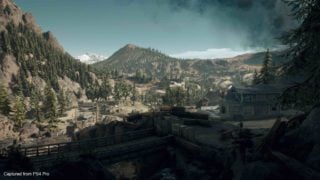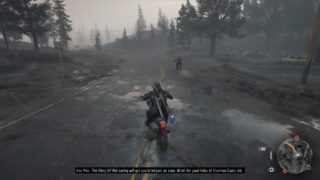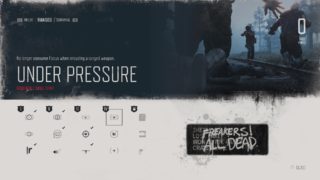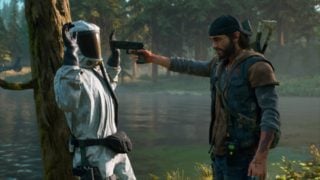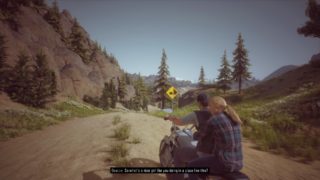Review: Days Gone rarely makes the case for its own existence
Sony Bend’s spry but soporific open world game reflects a genre gone to seed
- Creative Director
- John Garvin
- Key Credits
- Jeff Ross (Game Director), John Hoffman (Technical Director), Donald Yatomi (Art Director)
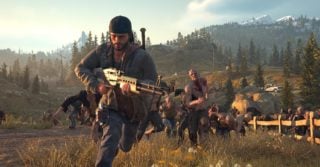
You’ll spend a lot of Days Gone preparing to travel north, away from the game’s zombie-sodden Oregon and the painful memories it harbours for grouchy outlaw protagonist, Deacon St John.
The journey never takes place, but you can readily imagine it – the twists, turns and rainslicked horizons conjured up by the roar of Deacon’s motorbike, a gas-guzzing Agro to your tattooed and unshaven Wander. The bike – your trustiest companion throughout Sony Bend’s competent but rather unnecessary open worlder – has a tendency to stop dead at the slightest impact that suggests an invisible Dodgem, but it’s otherwise a pleasure to ride, shooting into the corners and skimming dips in the road with enticing heft.

In the course of a game you’ll develop a workmanlike intimacy with it, buying new parts such as cowls for greater resilience, a faster engine and an ammo box for mid-mission refills. You’ll also need to keep it fed, either rolling up to a pump at a long-deserted gas station or plucking a jerrycan from the rubble (which may then serve as a tossable firebomb, to be popped with a slow-motion pistol shot).
When you get lost and run out of juice – easily done till you sponge away the map’s fog of war, and trade up to a larger tank – there’s the furtive enjoyment and admittedly, mild frustration of rolling the bike to the nearest safe point amid the incessant yowling of unseen, roaming infected.
I think there’s an intriguing tale to weave around that bike, a melancholy postmodern Western in the tradition of Cormac McCarthy, with drive-by flashes of older counterculture films like Easy Rider. Sadly, a number of things get in the way. One is Deacon himself, another of gaming’s weaponised male mourners, as morose and bloodthirsty as his lost wife Sarah was sunny and wholesome.
Now shacked up in an old watchtower with brother-in-arms Boozer, Deacon operates on the fringes of what society remains, hunting down marauders and rescuing the odd runaway. When one such oddjob goes awry, he’s forced to call in old favours and get more involved with the game’s four human settlements, building towards some predictable revelations as to the zombie plague’s origin.
As you go about thawing Deacon’s outlaw reserve, making new allies and rekindling friendships/grudges, you’re also put through semi-playable flashbacks to his and Sarah’s courtship. These involve quests to pick lavender, and dialogue lines such as “what’s a nice girl like you doing in a place like this?”.
Deacon isn’t the least likeable hero you’ve ever taken charge of, but he’s much the same mix of unearned gravitas and watered-down chauvinism (e.g. his honourable qualms about killing women) that bigger studios have been cranking out since The Last of Us. He also talks too much, chuntering to himself vindictively about nearby objectives and other characters as you lope through the undergrowth.
The game’s landscape would certainly benefit for not being talked over. It’s yet another exquisite study in desolation from an industry that specialises in them, an autumnal expanse of weedy railyards, farmhouses delicately strewn with belongings and hard-shelled field laboratories blackened by rotting fingers. It’s stitched together by tunnels that must be cleared of threats and obstacles, which creates a gentle cadence of claustrophobia and spaciousness, and there are the usual, unlockable fast travel points to ease the pain of back-tracking.
Sadly, exploring this sumptuous environment means reckoning with both the aimless plot, in which Deek coasts between factions mostly at the behest of mission completion percentages, and the utterly stagnant activity design.
“Deacon isn’t the least likeable hero you’ve ever taken charge of, but he’s much the same mix of unearned gravitas and watered-down chauvinism that bigger studios have been cranking out since The Last of Us.”
Days Gone‘s missions come in three, dreary varieties: follow a trail of clues to an object, clear out nearby enemies, and (less frequently) sneak past unkillable goons using undergrowth for cover. The combat is engrossing in short bursts, but lacks intricacy and flourish and is over-reliant on use of a slow-mo ability to nobble nippier adversaries.
The zombies or as they’re here known, “Freakers”, spawn all over the map, though full-blown 28 Days Later-style hordes are only found in a few hotspots. There are also bandits and the expected, later-game faction of scrawny, screechy born-again fanatics on loan from Mad Max. These human adversaries are only slightly brainier than the freakers, lacking the knack for cover you’ll encounter in, say, The Division 2.
Like Marcus Fenix long before him, Deacon wields two primary guns (which range from usefully silent crossbows to usefully indiscriminate SMGs) plus a sidearm, with a bootknife or craftable melee tool for sticky close encounters. It’s hard to miss approaching threats, the minimap flashing red as they near, but easy nonetheless to get cornered while searching structures for crafting resources or freaker boltholes in need of a Molotov cocktail.

The shooting and swinging is snappy enough, but evolves only a little over the course of the game. There are abilities to unlock, but these are seldom transformative – think finishers for melee combos, and less cooldown on your slowmo. You can also acquire different guns by earning credits at each camp and raising its overall “trust” level, but this is largely a question of accuracy and stopping power than new ways of playing. In a genre that relies above all on new moves and toys to sustain its bloat, Days Gone is perilously lacking in backbone.
So much “elegant” open world blockbuster game design now seems to consist of mitigating the open world blockbuster’s commercially mandated tedium, the sheer expanse of space and time that is apparently necessary to lure in buyers. Days Gone is awash with such thinking. You see it in the fuel mechanic, much as I found this constraint invigorating: it invests what would otherwise be weary toing-and-froing with slightly artificial suspense, your eye straying to the gauge as you play footsie with the gas pedal, eking every last joule of momentum out of every slope.
“So much ‘elegant’ open world blockbuster game design now seems to consist of mitigating the open world blockbuster’s commercially mandated tedium, the sheer expanse of space and time that is apparently necessary to lure in buyers”
You see it, too, in the way missions are bundled up into “Story lines” with a completion percentage, which are staggered over the course of the game – the result being that you usually have no more than three or four threads to think about at once, where many open worlders pack their inventory screens with half-run errands. We do admire Sony Bend’s craft on all these fronts but, as with the concept of artificial scarcity, they are solutions to a problem blockbuster games have created, by pumping their creations full of vapid “in-between” tasks to furnish the requisite weekend-swallowing length.
All of which invests Deacon’s repeatedly put-off goal of heading north with a certain tragedy: it’s as though the game were as eager to get away from itself as you are. Days Gone is far from the worst specimen of its genre but in a year already packed with 50 hour+ endeavours, it rarely makes the case for its own existence. The developer’s perverse insistence that you not call its zombies “zombies” (as far as we can recall, the word is never used in dialogue) only amplifies the game’s hollowness. If only it were shorter and less maudlin in its machismo, less reliant on busywork, and more invested in the thrill of riding a hand-tooled chopper beyond the end of the world.
Days Gone is far from the worst specimen of its genre but in a year already packed with 50 hour+ endeavours, it rarely makes the case for its own existence.
- A handsome recreation of Oregon
- An appealing focus on the motorbike
- Tedious mission design
- A totally uninspiring protagonist
- Chronic shortage of substantial new ideas






